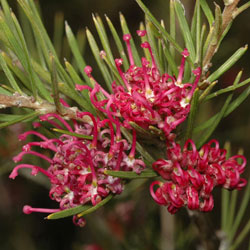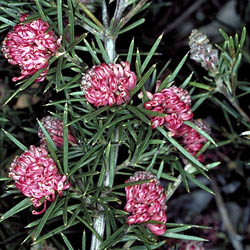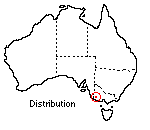Grevillea confertifolia
 |
 |
Grampians Grevillea, Dense-leaf Grevillea
Grevillea confertifolia F.Muell.
The shrub Grevillea confertifolia is commonly known as Grampians Grevillea or Dense-leaf Grevillea. It belongs to the Proteaceae family which includes the banksias and waratahs.
It grows naturally in the Grampians Mountains of Victoria where there are three recognised forms: a shrubby form, which occurs along creeks, and two low-spreading forms. These decumbent forms are restricted to damp sandstone plateaux at high elevations (1050-1150 m) in open forest.
 The
decumbent forms reach 30-60 cm in height and may spread over a distance of 1-3
m. They are ideal ground covers for low maintenance gardens and for landscaping
large areas. They form an attractive green mat of sharp, needle-like leaves,
2-3 cm long with rolled margins. The leaves are dark green above, lighter below,
and occur alternately along the stem.
The
decumbent forms reach 30-60 cm in height and may spread over a distance of 1-3
m. They are ideal ground covers for low maintenance gardens and for landscaping
large areas. They form an attractive green mat of sharp, needle-like leaves,
2-3 cm long with rolled margins. The leaves are dark green above, lighter below,
and occur alternately along the stem.
The flowers are 1 cm long when open and are borne in compact, terminal racemes 2.5 cm long and 2 cm wide with a stubby toothbrush appearance. They are available in two colours: one, a dark wine-red, and the other, from the Major Mitchell Plateau, a rosy pink. Flowering occurs in spring but the month of flowering varies with different climates. October is peak flowering time in Canberra.
Grevillea confertifolia is propagated from semi-hardwood cuttings, about 10 cm long, taken after flowering. Very soft tips should be removed as they may wilt and rot, creating ideal conditions for fungal contamination. A rooting hormone solution is recommended and cuttings should be placed in a sharp-draining propagation mix. Under nursery conditions the cuttings produce roots in two to eight weeks. Propagation from seed is unreliable.
In cultivation the decumbent forms grow well, tolerating quite heavy frosts and a variety of soil types, from heavy clays to well-drained rocky soils provided ample water is available. The addition of a nitrogenous fertiliser in early spring and late summer is highly recommended.
Specimens planted at the Botanic Gardens have taken nine years to reach a height of 60 cm and a width of 3 m, and have layered, that is, they have produced roots where the stem rests on the ground.
Scale insects are pests common to grevilleas and may cause considerable damage. If infestations are severe and no predators or parasites are evident chemical control may be used. The grevillea leaf miner, and other moth caterpillars which chew leaves and make webbing and frass, may also be a problem. If so, the bio-insecticide Dipel may be used for the leaf chewers and a suitable systemic insecticide may be used for the leaf miner. Contact local experts for advice.
Grevillea confertifolia has been commercially available for a number of years.
Text by Stuart Donaldson, ANBG (1986)
Name meaning: Grevillea confertifoliaGrevillea - after C.F. Greville (1749-1809), an English patron of botany; confertifolia - from the Latin, confertus, crowded, and folium, leaf, referring to the densely crowded foliage. |
![An Australian Government Initiative [logo]](/images/austgovt_brown_90px.gif)

